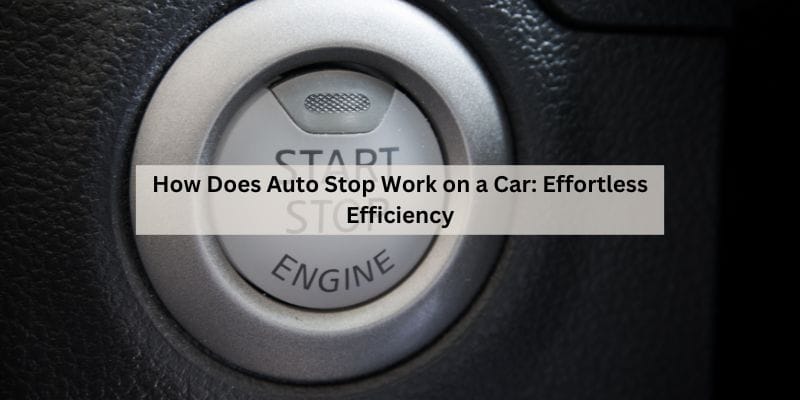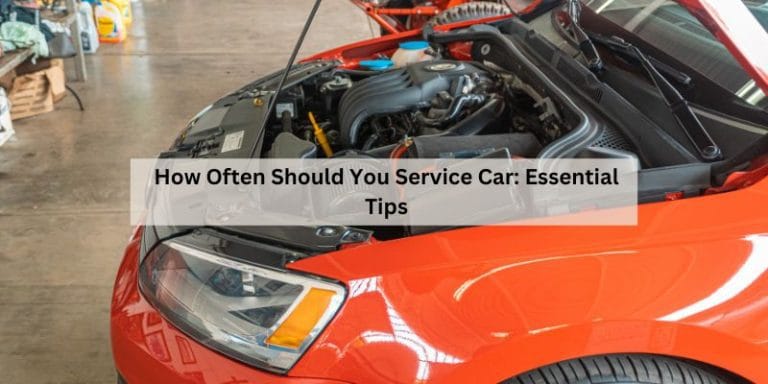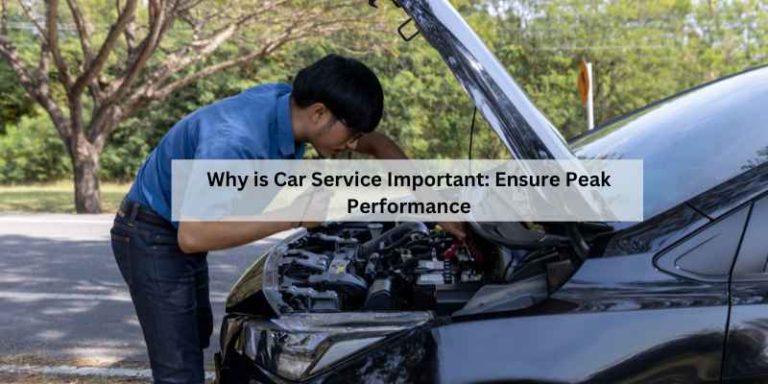How Does Auto Stop Work on a Car: Effortless Efficiency
Auto stop, also known as start-stop technology, works by automatically shutting off the engine when the vehicle comes to a complete stop, such as at a traffic light or in heavy traffic. This feature helps to conserve fuel and reduce emissions by preventing unnecessary idling.
When the driver releases the brake pedal, the engine quickly restarts, allowing the vehicle to resume normal operation. Auto stop is triggered by the actuation of the brake alone in vehicles with automatic or dual clutch transmissions. While this technology offers benefits in terms of fuel efficiency and environmental impact, it can also lead to increased wear on the engine and other components.
However, proper maintenance and precautions can help mitigate any potential issues.
Introduction To Auto Stop Technology
Auto stop technology, also known as automatic start-stop, is designed to improve engine efficiency and reduce fuel consumption. When the vehicle comes to a stop, the system automatically shuts off the engine, conserving fuel. As the driver releases the brake or engages the clutch, the engine seamlessly restarts. This technology has evolved to be compatible with automatic or dual-clutch transmissions, and it operates based on the driver’s braking behavior. While auto stop-start systems have the potential to save fuel and reduce emissions, there are some considerations to keep in mind. It’s important to understand the impact on the engine and the overall longevity of the vehicle.
One downside to the system is the potential for increased wear on the engine due to the frequent start-stop cycles. However, modern vehicles are equipped with features such as electric water pumps to maintain optimal engine temperature during stops. Additionally, the use of special batteries and voltage management systems helps support the auto stop-start functionality. Understanding the requirements and potential drawbacks of auto stop technology can help drivers make informed decisions about its benefits and impact on their vehicles.
How Auto Stop Works In Modern Vehicles
The auto stop-start system in modern vehicles is designed to save fuel and reduce emissions. This system is enabled by sensors that detect when the vehicle is at a standstill and the driver’s foot is on the brake pedal. The engine control unit (ECU) then initiates the auto stop by cutting off fuel and ignition, effectively shutting down the engine. When the driver releases the brake pedal, the system restarts the engine, allowing for seamless acceleration.
Key Components Enabling Auto Stop
Auto stop technology in cars is made possible by a combination of key components. Specialized batteries play a crucial role in supporting the frequent start-stop cycles. These batteries are designed to handle the increased load and discharge cycles. Additionally, voltage management systems ensure that the vehicle’s electrical components receive a stable power supply during the auto stop process. Moreover, HVAC modifications are implemented to maintain passenger comfort when the engine is temporarily shut off. Together, these components enable the seamless operation of auto stop systems in modern cars.
Benefits Of Auto Stop Technology
Auto Stop Technology, also known as start-stop technology, conserves fuel and reduces emissions by automatically shutting off the engine when the vehicle comes to a stop. When the driver releases the brake pedal, the engine restarts instantly, providing a seamless driving experience while saving fuel and reducing environmental impact.
| Benefits of Auto Stop Technology |
| Fuel savings |
| Reduced emissions |
| Prolonged engine life |
Auto stop technology is a feature that automatically shuts off the engine of a car when it comes to a stop, such as at traffic lights or in heavy traffic. This technology has several benefits, including fuel savings, reduced emissions, and prolonged engine life. With auto stop technology, the car’s engine is shut off when the car is stationary, thereby saving fuel that would have been wasted if the engine continued to run. In addition, reduced emissions are achieved because the engine is not idling unnecessarily. Lastly, the engine is subjected to less wear and tear, which leads to prolonged engine life. Overall, auto stop technology is a valuable feature that benefits both the driver and the environment.
Common Concerns And Myths
Auto stop, also known as start-stop technology, is a feature in cars that automatically turns off the engine when the vehicle comes to a stop. This helps to reduce fuel consumption and emissions. When the driver releases the brake pedal, the engine restarts seamlessly.
Despite common concerns, auto stop does not significantly wear out the engine and is generally beneficial for the car’s overall efficiency.
Real-world Impact
Auto Stop is a feature in modern cars that automatically turns off the engine when the vehicle is stopped in traffic and restarts it when the driver releases the brake pedal. This feature has a real-world impact on fuel economy, with some models boasting up to 10% improvement in city driving and 5% on the highway. Additionally, it has environmental benefits, with reduced emissions and lower carbon footprint.
To make Auto Stop work, there are certain requirements that need to be met. The vehicle must have an automatic or dual-clutch transmission, the battery must be a deep-cycle battery, and the HVAC system must be modified. However, some downsides to Auto Stop include increased wear on the engine and the potential for a less smooth driving experience.
If you are considering purchasing a car with Auto Stop, it is important to do your research and ask questions to ensure that it meets your needs and preferences. Ultimately, the decision to use Auto Stop is up to the driver and their driving habits.
Challenges And Limitations
Auto stop is a feature in cars that automatically shuts off the engine when the vehicle is at a standstill, such as at a traffic light or in heavy traffic. This helps to save fuel and reduce emissions. However, there are limitations to this system, such as increased wear on the engine and battery, and some drivers may find the frequent engine restarts to be inconvenient.
| Challenges and Limitations |
| Situations where Auto Stop may not engage: |
| – Auto stop may not engage if the battery is not adequately charged or if the outside temperature is too high or too low. |
| – In certain driving situations such as heavy traffic or hilly terrain, the system may not engage as frequently or may turn off altogether to prevent excessive engine wear. |
| – Some drivers may find the system jarring or intrusive, and may choose to disable it altogether. |
| Driver adaptation to technology: |
| As with any new automotive technology, it may take some time for drivers to adapt to the auto stop system. However, once familiarized with the system, drivers may find that it offers significant fuel savings and a reduction in emissions. It is important to note that while the system is designed to extend the life of the engine and reduce wear and tear, it may not be suitable for all driving situations. Drivers should consult their owner’s manual and consider their driving habits before deciding whether to engage or disable the auto stop system. |
Future Of Auto Stop Technology
Auto stop-start systems are becoming more prevalent in modern vehicles, especially with the rise of hybrid and electric cars. The integration of auto stop technology with these vehicles marks a significant advancement in the automotive industry. There is potential for this technology to become mandatory in the future, driving a shift towards more environmentally friendly and fuel-efficient vehicles. Despite its benefits in reducing fuel consumption and emissions, some concerns have been raised about the impact of increased stop-start cycles on engine wear. However, with proper precautions and technological advancements, the potential drawbacks can be mitigated, ensuring the long-term reliability and performance of the engine.
Faqs And Troubleshooting
Auto stop, also known as start-stop, is a feature in modern cars that automatically shuts off the engine when the vehicle comes to a stop and restarts it when the brake is released. Disabling Auto Stop is possible through various methods, including using a specific button or consulting the vehicle’s manual. Troubleshooting common issues with auto stop involves checking the battery, starter, and electrical system for any malfunctions. Some drivers prefer to disable auto stop to prevent wear and tear on the engine, while others appreciate the potential fuel savings it offers. It’s important to weigh the pros and cons of auto stop and consult a professional if experiencing persistent issues.
Frequently Asked Questions
What Triggers Auto Start-stop?
Auto start-stop is triggered when a vehicle with automatic or dual clutch transmissions comes to a standstill and the driver’s foot remains on the brake pedal. The system stops the engine to save fuel and reduce emissions. However, it may lead to increased engine wear and additional wear on the DPF exhaust system.
What Is The Downside To The Start-stop Engine Feature?
The downside to the start-stop engine feature is that it can increase wear on the main engine and the DPF exhaust system due to the additional hours of idling. However, the potential damage is not as significant as cold starts because the engine is already at operating temperature.
The stop-start system also uses electric water pumps to maintain optimal engine temperature when the vehicle is stopped.
Is Auto Stop Good For Your Car?
Auto stop, also known as start-stop technology, is good for your car. It helps save fuel and reduce emissions by automatically turning off the engine when the vehicle is at a standstill. The engine is quickly restarted when the brake is released.
This system is designed to minimize wear on the engine and uses electric water pumps to maintain optimal temperature when stopped.
Is Stop-start Bad For Cars?
Stop-start technology is not bad for cars. It automatically shuts off the engine when the car comes to a stop and restarts it when the driver releases the brake pedal. This feature helps reduce fuel consumption and emissions. The engine is designed to handle the increased number of start-stop cycles, so it does not cause significant wear and tear.
Conclusion
Auto stop is a feature in cars that automatically shuts off the engine when the vehicle is at a standstill and the driver’s foot remains on the brake pedal. This technology helps to reduce fuel consumption and emissions, making it more environmentally friendly.
However, it is important to note that auto stop-start systems may lead to increased wear on the engine and battery. Despite this drawback, the benefits of auto stop outweigh the potential downsides, making it a beneficial feature for modern cars.







